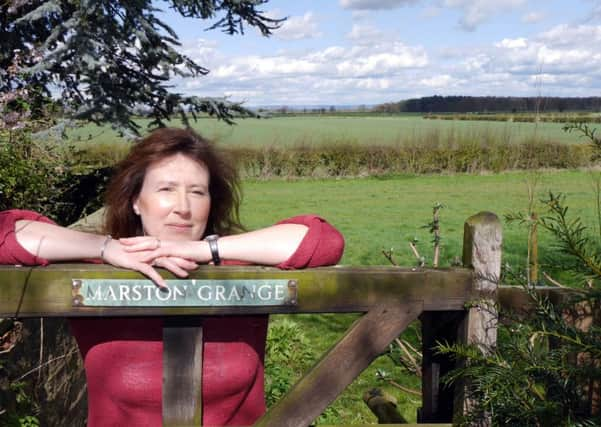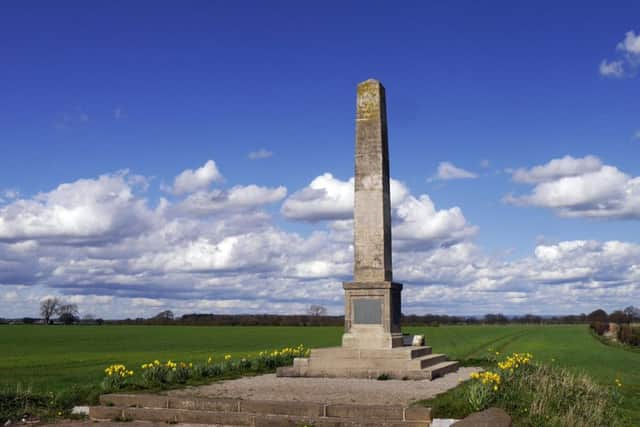The forgotten Yorkshire battlefield fighting to regain its place in history


On a bright, spring day, Marston Grange farm looks pretty idyllic. The Smakman family have been growing wheat and barley on this land since 1942 and soon the fields will turn bright yellow and this year’s rapeseed crop comes into full bloom.
Apart from the gentle hum of the tractor, there is not much which disturbs the peace in this corner of Yorkshire, but it wasn’t always this way. Wind back to the summer of 1644 and these fields were about to turn red with the blood of a thousand troops as the English Civil War intensified.
Advertisement
Hide AdAdvertisement
Hide AdOne of the biggest battles ever fought on British soil, on the evening of July 2 more than 40,000 soldiers descended on Marston Moor, each side desperately defending their cause.


On one side where the Royalists. On the other were the Parliamentarians and the clash, on land between Wetherby and York, marked a turning point in the bitter conflict, which had begun in 1642. Over the course of two hours, events swung against King Charles I, not least because of the leadership of Oliver Cromwell, whose cavalry charged and regrouped to unleash mayhem on the enemy ranks.
By nightfall more than 4,000 men were dead. Many more had been injured and captured and the north of England had been lost to the crown. The brutal encounter had a far more profound effect on the course of English history than battles at nearby Towton and Bosworth in Leicestershire and yet it is far less well known.
Jo Smakman hopes to change all that and is on something of a mission to restore Marston Moor to its rightful place in history. The trained archaeologist married into the farming family and with a background in marketing she also hopes that its links to Cromwell will help the 406 acre arable operation diversify.
Advertisement
Hide AdAdvertisement
Hide Ad“There is no good reason why the Battle of Marston has been overshadowed by both Towton and Bosworth,” says Jo. “But it does deserve to be much better known and because of my background in archaeology I do think that there is a really fascinating story to tell here.”


The Smakman’s farmhouse is located on the part of the battlefield where Cromwell’s cavalry and that of Prince Rupert faced each other and beneath the fields of carefully planted crops lie the remnants of the 373 year old battle.
“From our own research we know the Parliamentarian troops, commanded by Ferdinando, Lord Fairfax, Cromwell and the Earl of Manchester were amassed on the southern rise of Marston Moor and gained the advantage of the ridge and the highest ground, now referred to as ‘Cromwell’s Plump’,” says Jo. “ Prince Rupert, the Marquis of Newcastle, Lord John Byron and Lord George Goring took up positions on the open Moor behind Marston Grange.
“We know that some of the land was under cultivation at the time of the battle as there are references to the Parliamentarian troops wading through corn. It would have been hard going as it would not have been as we know corn today, at knee or thigh height, but up to their waists, or even shoulders.
Advertisement
Hide AdAdvertisement
Hide Ad“There has never been a full excavation of the site. It is so huge I’m not sure where you would start, but we have found belt buckles, musket balls and spurs belonging to those who fought here. It give me goosebumps to just hold them.
“The lay of the land is now agricultural, but with a bit of guidance you can still see features that played a part in the battle such as hedges and woodland. We can never forget what happened here and we want to give other people the chance to learn about this fascinating chapter in the history of Yorkshire.”
The Smakmans are now teaming up with the recently opened National Civil War Centre in Newark and the Royal Armouries in Leeds to host a battlefield day on the farm on June 3. As part of the event, there will be access to parts of the site normally off-limits to the public, a chance to examine some of the most poignant finds and an opportunity to learn more about the tactics, arms and armour that made Marston Moor so deadly that day.
A number of battlefield experts will also be on hand during the event, including Keith Dowen from the Armouries, Glyn Hughes from the National Civil War Centre and author Dave Cook, an authority on Yorkshire’s Civil War past, will also be leading a battlefield tour.
Advertisement
Hide AdAdvertisement
Hide Ad“Marston Moor is one of the best preserved and most evocative sites from the period,” says Hughes. “The battle was hugely important as it was the beginning of the end for King Charles. Most of the key figures were here - Cromwell, Fairfax, Leven, Goring and Prince Rupert. At the end of that day in June the crown lost control of the northern shires, York and the North Sea ports, which was a terrific blow.”
The seeds of the divisive battle were sown following the Royalists’ successful move to relieve the siege of York when the dashing Prince Rupert, then the most feared soldier of his day had arrived in the nick of time to stave off the threat.
However, instead of consolidating his hold on the city Rupert chose to meet his enemy in a pitched battle at Marston Moor, citing orders from the King to destroy the rebel army, even though he was outnumbered by an allied Parliamentarian and Scottish force 28,000-strong.
Even so, for a while the battle swung in favour of one side then the other - in the confusion some Parliamentarians and Scots, thinking the fight was lost, fled towards Leeds. However, Cromwell’s cavalry, dubbed the Ironsides, rallied. They tore into the King’s ranks and while Cromwell himself was wounded in the neck he recovered enough to sweep around the Royalist rear, relieving his beleaguered soldiers and sealing the day,
Advertisement
Hide AdAdvertisement
Hide AdWhile may of the Royalists fled or were captured, Some stood their ground, including the Marquis of Newcastle’s Whitecoats, who were repeatedly charged by the Ironsides until just 30 were left alive.
Reports of ghostly armies flanked by pillars of light appearing to re-fight the battle circulated for years afterwards such was its impact on the nation’s psyche. The more earthly reckoning was that King Charles never recovered from the setback. York fell two weeks later and within two years he surrendered to the Scots at Newark in May 1646.
“It’s strange to think that such a beautiful location could have witnessed such events,” says Jo. “Our job now is to nurture this special place and help people understand what happened here all those years ago.”
The Marston Moor Battlefield Day runs between 10am and 3pm and includes refreshments and a buffet lunch. Places costing £35 per person are limited. For more information and to book go to marstongrange.co.uk